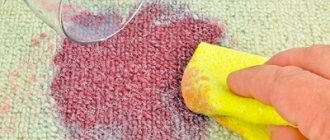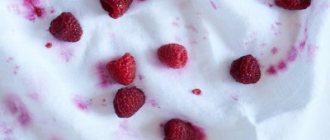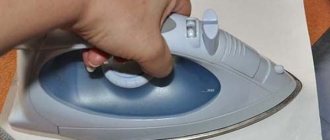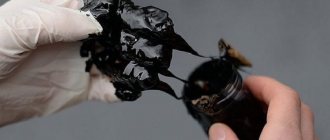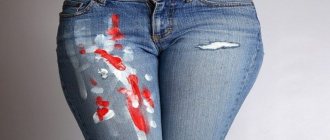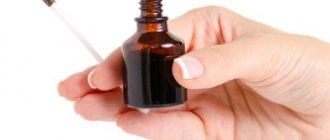The easiest way to remove blood from jeans is if you immediately begin removing the stain. But even if you couldn’t immediately start cleaning your jeans, and the stain has dried, then don’t despair, there is a way to clean even dried blood.
To remove complex stains, we advise you to order furniture dry cleaning.
Before you begin removing stains, you will need to remove any excess blood. To do this, you can use a sponge or paper napkin. Just press the sponge firmly against the jeans, but don't rub it, and rinse off any excess blood.
Method 2 – Ammonia and dishwashing detergent. Suitable for dried stains.
- Place the jeans on a hard, flat surface, such as an ironing board.
- Mix a cleaning solution - half a liter of cold water per tablespoon of dishwashing detergent.
- Soak a microfiber cloth or any other cloth in the solution and place it on the stain. Give the solution 15 minutes to absorb.
- To remove the stain, arm yourself with a toothbrush and start cleaning, just do not rub too hard so as not to enlarge the stain.
- To remove the product, moisten a cloth in water and apply it to the stained area. If after the above steps the stain does not disappear, then proceed to the next step using ammonia.
- Mix half a glass of cold water with 1 tablespoon of ammonia.
- Using a spray bottle, apply the solution to the stain and leave to sit for 5 minutes.
- After each 5 minutes, blot the stain with a clean cloth. Repeat spraying and blotting until the stain is gone from the jeans.
- Pour cold water into a basin and rinse your jeans in it.
- Wash your jeans in the washing machine.
First actions
But it is obvious that when a person is injured, efforts are primarily aimed at stopping the bleeding. Nobody thinks about washing at this moment. They remember about clothes no earlier than an hour or two later. Therefore, as a rule, it is no longer possible to do without additional funds, and traces of blood should be divided into “conditionally fresh” and old.
In both cases, “first aid” for pants will be identical. Before resorting to soap, powder or stain remover, you should try to wipe the blood off your jeans with cold running water. Be sure to turn them inside out. As soon as the top brown layer comes off, soak the pants in a basin. After an hour, you can evaluate the result and understand what additional funds will have to be used.
Method 4 – Porridge of cold water and salt
- Place the jeans on a hard, flat surface, such as an ironing board.
- Mix a slurry of cornstarch (2 tablespoons), a quarter cup of water and table salt (1 tablespoon). The consistency should be like a paste.
- Apply the paste onto the stain using a spoon and let it dry.
- Remove excess paste.
- Soak your jeans in cold water and rinse them well.
- Wash your jeans in the washing machine.
What absolutely cannot be done?
Cold water is that simple. Why then is blood considered a difficult-to-remove contaminant? The thing is that many are not familiar with this rule. One mistake is enough for your jeans to be irreparably damaged.
It is strictly forbidden to:
- Wash jeans in hot and warm water. We are talking not only about hand washing, but also about machine washing. At 42 degrees, the blood already begins to clot, firmly eating into the tissue. It feels like 40 degrees is barely warm water. Do not open the hot tap at all, and choose a machine wash at 30 degrees to be sure to avoid mistakes.
- Rub the stain. When blood gets on jeans, many people instinctively try to wipe the stain away. There is no need to do this. Trying to remove blood “dry” or using a damp cloth, you only increase the area of contamination. It is better not to touch the stain at all until you have had the opportunity to remove and thoroughly wash your pants with water.
- Use bleach. Bleach and bleach will remove anything. However, they corrode not only dirt, but also fabric fibers. In the best case, the fabric will lighten in place of the blood stains, and in the worst case, a hole will appear.
- Use peroxide, salt, soda, ammonia without a preliminary test. These products, known to many, have whitening properties. Together with the blood, they can wash the dye off your jeans. Therefore, you must first apply the composition to an inconspicuous place. If the fabric has not faded, you can safely use it.
Traces of blood never disappear without a trace. This is known to all investigators. Even if the product looks perfectly clean on the outside, after decades it will be easy to determine that blood has come into contact with it. Once you shine it with ultraviolet light, the stains will be easily revealed. This effect is provided by hemoglobin iron and porphyrin rings contained in human blood.
Method 5 – Baking Soda
- Prepare a cleaning solution. Mix cold water and baking soda in a 2 to 1 ratio.
- Apply the resulting solution to the stain and let it soak in for 30 minutes.
- Soak your jeans in cold water and rinse them well.
- Wash your jeans in the washing machine.
Adviсe
A professional cleaning company will be happy to help you for a nominal fee.
If you decide to use a store-bought branded product to remove a stain, then in order to choose a good product, you need to make sure that it contains a protein base.
How to remove with household chemicals?
Among the household chemicals presented on the shelves of hardware stores, the following successfully cope with bloody stains on clothes :
- dishwashing detergents;
- washing powders containing enzymes;
- oxygen bleaches and stain removers: Vanish Oxi Action, Amway PreWash, Sarma Active, Ecover and others.
Nowadays you can find special stain removers on sale that are designed to remove blood stains. They are used according to the attached instructions.
Bloody marks on jeans from menstruation can be easily removed with Antipyatin soap. It has a stronger impact than the economic one. They also rub the stain and wait about 3 hours. Then the item is rinsed and washed.
Of all the industrial stain removal products, it is worth highlighting the most popular:
| Brand name | Minuses | pros |
| ACE OXI MAGIC | Does not always cope with stains when washed in cold water. | Suitable for colored products, inexpensive, does not spoil the structure of the fabric. |
| Udalix Oxi Ultra | Only works in warm water. | Suitable for any materials. |
| Astonish OXY PLUS | Too expensive compared to analogues, sold via the Internet. | It contains potent sodium carbonate peroxyhydrate, is harmless to humans, removes even stubborn stains, and is suitable for colored and white fabrics. |
| Sarma Active 5 in 1 | It dissolves poorly and takes a long time to wash. | Low price, suitable for all products, contains enzymes. |
All of the above products are used shortly before the main wash . If it is a spray or pencil, then by treating the problem area. When the drug is in powder form, dissolve it in water (according to the instructions on the package) and soak the trousers in the solution.
Squeeze the dishwashing liquid onto the stain, then begin to rub vigorously until foam appears. After rinsing with water, look at the result and repeat the procedure if necessary.
Special compounds and stain removers
Despite the fact that stain removers belong to the category of household chemicals, they require more detailed study.
And all because they are the ones who will help you quickly, effectively and safely deal with blood that gets on your jeans.
Before using any product, test in an inconspicuous area. In addition, always follow the instructions provided by the manufacturers and on the label.
The list of the most popular stain removers includes:
Vanish. Among the advantages: no chlorine in the composition, reasonable price (from 99 rubles per 400 ml). The product can be applied both to the stain on the jeans itself and to the water in which the soaking will take place.
Udalix. Despite the fact that the product belongs to the category of bleaches, it does not affect the color and is suitable for any fabric, including denim. All thanks to active oxygen, nonionic surfactants and enzymes. The release form is very different - both in powder form and in pencil form, which simplifies application. The disadvantages are that the product only works in warm water and is difficult to find in stores. The method of application is very simple: apply to the blood being removed and leave to act. The price starts from 70 rubles.
AceOxiMagic. Quite a budget product - for 500 grams you will have to pay a little more than 100 rubles. Another indisputable advantage is that the stain remover does not spoil the structure of the fabric. The disadvantages include the fact that the stain remover is effective only in warm water. The product is added both during the soaking process and during washing.
When making a choice, give preference to products that contain active oxygen. But you should avoid bleaches with chlorine, as there is a risk of discoloration of the problem area of the jeans.
Useful tips
For those who decide to remove traces of blood from jeans at home, when, for example, menstruation has arrived, little secrets will help:
- Before using the product, household or industrial, it is necessary to check the fabric for compatibility. Apply a small amount to the inner seam. After all, it is impossible to predict the reaction of coloring with chemistry.
- When scrubbing blood from denim, you should be careful. There is a risk of perforating the fabric. This is especially true for thin jeans.
- Without rubbing, the potato starch will be removed from a light cloth. It is diluted with water to a paste. Gently soak both sides of the product with the mixture and wait until it dries completely. The remaining blood goes away after the normal washing procedure.
- Places with fittings should not be soaked in water for a long time. Oxidation of the metal will give red marks.
- The easiest way to clean completely white jeans is to use bleach. But you cannot rub and soak, otherwise the treated area will still differ in color.
In rare advanced cases, even dry cleaning cannot help completely remove blood from jeans. Even in such a situation, you should not consider the product hopelessly damaged. Problem areas can be easily cut off to create capri pants, breeches or shorts. Stains can be covered with embroidery or appliqué. Torn models continue to be relevant; no one will notice that there was a stain in place of the fashionable wear.
How to remove blood stains from clothes if they are fresh
Information has long been collected and classified about how blood can be washed off if it has not yet managed to completely penetrate the structure of the fibers. A lot of improvised means are used, successfully tested in folk practice.
Soap
The easiest way to remove blood stains is with laundry soap, although the toilet variety will do if necessary. The damaged area is moistened and the underside is generously soaped. Set aside for 20 minutes. After rinsing, check the result. If the yellowness remains, repeat the procedure.
We recommend reading: How to wash fuel oil when washing powders and stain removers do not help
Ammonia
Take a tablespoon of the product for half a glass of water. Moisten the stain with the liquid and leave for an hour. If after a single exposure it was not possible to remove the stain, the manipulation is repeated. This technique is not suitable for satin or silk.
You can prepare a mixture by taking a teaspoon of ammonia and borax per two tablespoons of water (certainly cold). After applying the composition to the stain, rinse the item thoroughly.
It is easy to remove blood if the clothes are quickly soaked in four liters of water, to which 50 ml of ammonia and a tablespoon of dishwashing detergent have been added. Wash after an hour.
Hydrogen peroxide
Before removing stains with hydrogen peroxide, make sure that the product will not lighten the fabric. On colored clothes, it is advisable to first apply a few drops to the hem on the wrong side and visually assess the possible color change. If there are no negative consequences after the test, then use an old toothbrush to wipe the bloody marks with 3% peroxide and wash the item after 10 minutes.
You can additionally rub the area of fabric already moistened with peroxide with laundry soap and leave for half an hour before washing.
Allows you to solve the problem of how to remove blood stains with a mixture of hydrogen peroxide (50 ml), salt (a tablespoon) and starch (twice as much). It is distributed over the surface of the dirt, rubbing in with a spoon. After drying, carefully remove the residue and apply a damp cloth to the fabric.
Meat tenderizer
Sometimes they choose among the advice on how to remove blood a non-standard one: use a powdered meat tenderizer. The method is not suitable for satin and silk - it will damage the fabric. Carefully study the composition of the softener. There should be no dyes, flavors, or aggressive chemicals. Add water to the powder to obtain the consistency of a viscous porridge, spread the mixture over the stain. After 15 – 20 minutes, you can rinse with cold water.
Aspirin
When deciding how to get rid of bloody marks on woolen fabric, you can crush and dissolve an aspirin tablet in a glass of water. Wet a cotton swab generously in the resulting solution and wipe the stain.
Or another way. Grind the tablet to a powder, add a little water, place the resulting pulp on the blood trail. After 10 - 15 minutes, rub the stain with a toothbrush, pouring cold water on it.
Salt
Salt will help you get rid of blood stains if you pour it onto the affected, pre-moistened area of the fabric and rub it into the textile with your fingertips. After this, pour a household cleaner onto the stain. Add a pinch of salt to the resulting foam and rub the dirt. After these manipulations, wash the item.
Additional Tips
How to wash off blood to preserve the decor of your favorite item.
Removing bloody marks from white items
Hydrogen peroxide helps in this situation. After 15 minutes, wipe the stain soaked with this product with a clean napkin. Do not use on thin, delicate fabrics.
Cleaning blood from jeans
Baking soda helps you cope with the task of removing a blood stain from your favorite jeans. The trousers are kept in a solution (0.5 liters of water - 30 g of soda) for 40 minutes and washed, carefully working on the contaminated area.
How to save items made from delicate fabrics
To remove blood stains without harm from silk or other delicate fabric, use starch paste. Leave on the stain until it dries. Wipe off the residue with a napkin and send the item to the wash. When rinsing, add vinegar to the water.
Preliminary recommendations
Depending on the freshness of the blood, the methods of purification vary. For example, baking soda, aspirin, peroxide or regular table salt are perfect for fresh. And ammonia or glycerin can successfully deal with old ones. There are other rules, the application of which is important when removing blood from jeans.
Key points to consider when removing blood from jeans:
- Timely washing. If possible, wash immediately.
- Removal of blood using third-party compounds other than water is carried out after maximum removal of contamination particles.
- The use of hot water is not permitted. When in contact with water above 30 °C, blood coagulates and penetrates more deeply into the fibers, which reduces the possibility of washing. And the dark stains that appear due to the presence of iron in the blood will remain on the jeans forever.
- When using bleach when working with white jeans, you should neither rub nor soak - otherwise the place where you wash it will have a different shade. For jeans of other colors, soaking is necessary. It is done before washing, which will allow the product to penetrate the fibers of the fabric.
- The duration of soaking should not exceed 30 minutes with a double change of water. Exceeding the time may lead to oxidation of metal elements.
- The product should be tested in an inconspicuous area to avoid damage to the jeans.
Considering the density of denim and the need to use cold water, it is allowed to use an ordinary piece of ice for soaking. Cooled protein is removed from the fibers faster.



